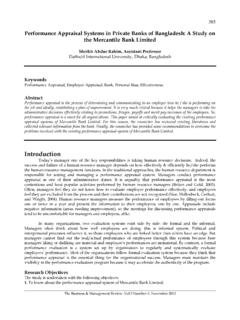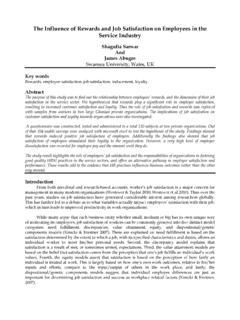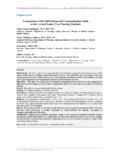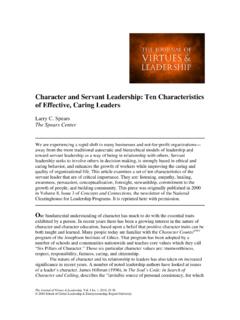Transcription of Effective communication brings successful …
1 Effective communication brings successful organizational change Zareen Husain Department of Business Administration, Aligarh Muslim University, Aligarh, India Keywords organizational communication , organizational change , communication Objectives, Business Organizations. Abstract The purpose of this paper is to recognize and discuss the significance of Effective communication during the process of managing changes in organizations. The paper reviews the literature investigating the relationship between communication and organizational change . The advantages of successful communication related to improved efforts of employees to plan and execute change strategies are also discussed. This paper also identifies the objectives and communication needs for each stage of the change process. Also, the various motives and benefits of organizational communication are discussed.
2 It defines the organizational communication and presents its various objectives. The means to achieve these objectives and their advantages are also described. The paper offers a change communication model which identifies different variables facilitating Effective communication and finally ensuring successful organizational , it highlights the aspects of communication which has proven to be useful for successful changes in business organizations. It would be of value to practitioners and researchers seeking to develop their communication skills and encourage members of staff to demonstrate improved results. Introduction organizational change has widely become an area of focus in management literature. Despite the growing significance and research, many of the attempts to generate organizational change fail.
3 Recent studies reveal that change efforts often suffer a dismal fate. Some research indicates a failure rate of one- third to two-thirds of major change initiatives (Beer & Nohria, 2000; Bibler, 1989); more pessimistic results suggest a higher rate of failure (Burns, 2004) that may reach up to 80 to 90 percent (Cope, 2003) or may make the situation even worse (Beer et al., 1990). Researchers have found that at least more than half of all the organizational change programs do not reach the results which they intended to produce (Bennebroek et al., 1999). Poorly managed change communication results in rumors and resistance to change and enlarging the negative aspects of the change (DiFonzo et al., 1994; Smelzer & Zener 1992). communication is considered to be vital for the Effective implementation of organizational change (DiFonzo & Bordia, 1998).
4 The importance of communication during intended change has been empirically demonstrated and commonly agreed among practitioners. The empirical picture appeared indicated that organizational change and communication process are inextricably related processes (Lewis, 1999). Recent studies about communication show that communication has positive correlation with many organizational outputs like organizational commitment, performance, organizational citizenship behaviors, and job satisfaction. In contrast communication failure may cause functionless results like stress, job dissatisfaction, low trust, decrease in organizational commitment, severance intention, and absence (Bastien, 1987; Malmelin, 2007). and this can affect organization's efficiency negatively (Zhang & Agarwal, 2009). communication during organizational change reduces resistance to change .
5 When resistance to change levels is low within an organization, the change -effort turns out to be more productive. The change plan is dependent of capacity of the organization to change the individual performance of each employee (Goodman & Dean, 1982;. Robertson et al., 1993, Tannenbaum, 1971). Since organizational change introduces variation of tasks given to individual employees, transmission of information to these employees on future change is an essential and integrative part of the change strategies. The objective of this paper is to focus on the role of communication while managing changes in business organizations. It appreciates the need for communication during organizational change . The strategies to make employees educate and understand the need for change is also described. The paper also aims at building a change communication model by identifying the various variables which affect communication process and resulting in successful organizational change .
6 organizational communication Kreps (1990) defined organizational communication as the process whereby members gather pertinent information about their organization and the changes occurring within it. Generally organizational communication has two objectives. The primary objective is to inform the workforce about their tasks and the policy issues of the organization (De Ridder, 2003; Francis, 1989). organizational communication is defined as transmitting news about the work from organization to employees and through employees (Phattanacheewapul & Ussahawanitchakit, 2008; Chen et al., 2005). The second goal of organizational communication is to construct a community within the organization (Francis, 1989;. Postmes et al., 2001; De Ridder, 2003). Meaningful communication informs and educates employees at all levels and motivates them to support the strategy (Barrett, 2002).
7 This is important as positive attitudes to change are vital in successful change programs (Kotter, 1996), as resistance to change is one of the biggest barriers to overcome. Meaningful communication requires a degree of cognitive organizational reorientation' (Van Vuuren &. Elving, 2008) comprehension and appreciation of the proposed change . Elving and Hansma (2008). carried out interview research between management and employees during organizational change . The most important conclusion drawn was that the success of the dissemination and adaptation of organizational change significantly depend upon communicative and informative skills of managers at all levels. Although leaders appear to be aware of fast change within organization (Bolden & Gosling, 2006), communicating that change is difficult (Lewis, 2000).
8 Bennebroek-Gravenhorst et al. (2006) found that along with the role of management on the contribution of the workforce to the impending change , distribution of information and actual communication regarding the need for the change and the objectives of the modification in business organization are also critical. Elving (2005) proposed a conceptual framework to study communication in organizations experiencing change . Six propositions were developed that all simultaneously influence readiness for change . The level of readiness in this framework indicates the degree of effectiveness of change . The first proposition stated that low level of resistance to change or high level of readiness for the change is an indicator for Effective organizational change . The second proposition stated that communication needs to inform the organizational members about the change and how that change will alter the individual's work.
9 The third proposition advocated that communication should be used to create a community which will increase commitment, trust, and identification with the organization and management. The next proposal looked at uncertainty in that high levels of uncertainty will have a negative effect on readiness to change . The fifth proposition focused on the effect of downsizing creating loss of jobs and feelings of job insecurity affecting readiness to change . The last proposition was related to fourth and fifth propositions which stated that communication will show impact on feelings of uncertainty and job insecurity. According to Klein (1996), the communication strategy should coincide with the general stages of the change process and the relevant associated information requirements. Based on Lewin's change model (1951), Klein has identified the objectives and communication needs for each stage of the change process.
10 Communicating during the unfreezing stage': During this stage, the primary communication objective is to prepare employees and the organization for the change . This step is also identified as readying the organization. Resistance will increase at the same rate with how big the change is and how much it affects the organization. However, it is much easier to overcome this resistance if the communication strategy is designed to account for the initial resistance (Klein, 1996). In order to ready the organization for the change , it is important to communicate the objective of the change and what is going The Business & Management Review, Number-2, January 2013. 44. to happened and why ought to be conveyed. The first thing that needs to be communicated is the need for change , by pointing out the discrepancy between desired outcomes and actual outcomes.















